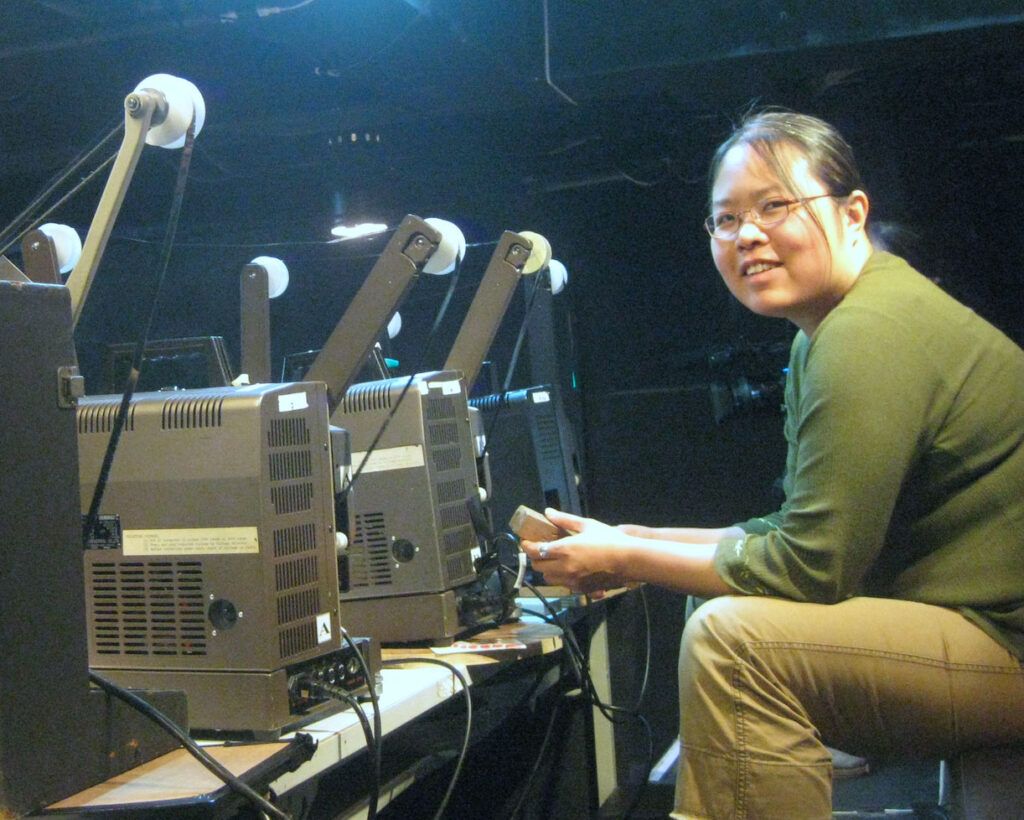
The idea of pattern (in terms of graphics, visuals and sounds) seems to be very present in your work, could you tell us a bit about this?
It was never intentional for me to use graphic or geometrical motifs. Each piece started out independently with a curiosity. For End Rolls, it was to capture colour light fluctuations that one sees in the beginning and end of a film reel. For Autumn Fog, it was the autumnal colours and light in my garden; and for Washi series, it all began with my attraction to one drawing by artist Mary Martin. I also wanted the sound to be as honest to the image as possible by using the same approach, “reading” sounds directly from images themselves, optical sound.
I would say there is a kind of visual rhythm in the way I think at every stage of the filmic process, from creating the images and sounds to presenting them. Within the rhythm there is constancy as well as pauses. There are also restrictions and rules either from the process or applied. Sometimes mathematical methods are used but there is an equal amount of trust in chance happenings.
So reflecting on all this, “pattern” is an interesting description and quite relevant throughout my moving image work.
How do you think your music background has permeated your cinema work?
Only after having made a few films, I realized my background in music has helped me shape my filmmaking. I think the sense of time and movement, even stops and pauses may be subconsciously coming from my music background. I have used the structure of music in one of my early films adopting the four movements of a symphony to construct an experimental film essay called Unfinished Symphony (2001).
I was classically trained in piano but I do listen to all kinds of music. Like any art form, music has many structures, themes and rules. An artist finds their own freedom and inspiration within all this to discover what moves them and hopefully this will be sensed by the audience. The outcome of artworks are like compositions of artists’ sentiments. I think that is my philosophy when I work with moving images.
You are bringing to the festival some multi-projector works. What drew you towards this kind of work in the first place? How has the multi-projector approach changed over the years?
I was only making single-screen films until 2004 when I attended a three-day festival in Dortmund entirely focused on expanded cinema. It broke down all the walls of cinema for me. Werner Nekes’s Cuts for ABABA, Malcolm Le Grice’s Matrix, Gill Eatherley’s Hand Grenade, Lis Rhodes’ Light Music, William Raban’s Take Measure, Guy Sherwin’s Paper Landscape and Man with Mirror, Morgan Fisher, Valie Export, Bruce McClure, etc. I was drowned in a kind of filmmaking that I was not familiar with. This sparked off my curiosity as to how I can contribute to this genre and what kind of work I would make.
I began to experiment with a camera-less work called O. Printing letterforms frame-by-frame onto transparency, then exposed onto raw film, home-processed and choreographed using basic functions of the film projector to make a two-screen performance work. This way of thinking slowly developed and evolved over the years. I enjoy the honesty in the process, from making to projection. Nothing is hidden between frame and screen. I am sure this “honesty” can be felt and shared with the audience too. Just like a brush to a painter or a chisel to a sculptor, I am using the tools of filmmaking to create moving images that will move me.
You are bringing a work in progress, Asanoha, based on the Kumiko Japanese craft. How did you discover Kumiko and what made you think about translating this idea into cinema? How has this work evolved?
I was familiar with the pattern Asanoha through another Japanese craft called Sashiko, a kind of embroidery skill for fabric repair. When I was looking into local traditions at an artist-residency at Center in Japan, I came across Kumiko that uses the same patterns but with different functions. Kumiko is an amazing traditional wood-latticework that has been around for hundreds of years. Delicate repeated geometric patterns crafted in ultra-thin pieces of cypress wood skilfully put together without nails to create large panels traditionally used for sliding door screens or dividers to diffuse light and wind in living spaces. Toyoda-san, a Kumiko craftsman who I was introduced to, says it all begins with exact equilateral triangles. He showed us how it is made and the evolution of the craft. The skills and knowledge in the qualities of this technique developed over centuries carried down to today’s artisans enabling them to make delicate and powerful effects. I find similarities in Kumiko to the process for film craft.
I had a few ideas on how I can translate this onto film. I decided to use the idea of Steve Farrer’s 10 Drawings as a start. Strips of clear 16mm film are laid into a rectangle and the pattern of Asanoha (Hemp leaf) is drawn onto it. I did the same using 16mm black film but this time scratched the pattern into its emulsion. The lines are drawn and scratched over to the soundtrack side of the films as well. They were later joined back into two reels, one with clear film and one with black film. I screened a version at Center, to the local community in Kanuma City in March this year. Since then, I have developed this work further but it’s still not completely finished. This second work-in-progress screening of Asanoha will be shown for the first time outside Japan at (S8) Film Festival.





